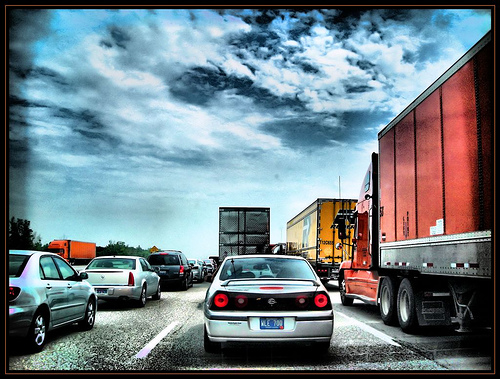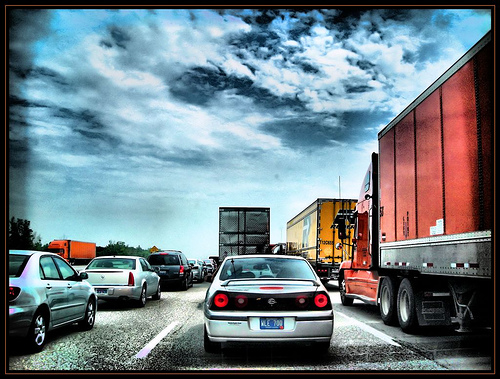 It doesn’t have to be this way.Photo: Kathy McEldowneyWith action on transportation policy utterly stalled out at the federal level, the best hope for reforms that would lead to a reduction in carbon emissions from transportation might lie with the states. Emphasis on might. Because with some exceptions, they’re not doing so great either.
It doesn’t have to be this way.Photo: Kathy McEldowneyWith action on transportation policy utterly stalled out at the federal level, the best hope for reforms that would lead to a reduction in carbon emissions from transportation might lie with the states. Emphasis on might. Because with some exceptions, they’re not doing so great either.
In an effort to move things forward, the Natural Resources Defense Council, in partnership with Smart Growth America, put out “Getting Back on Track.” The study ranks all 50 states on a variety of policy criteria that indicate a commitment to reducing transportation emissions — including safe routes to school programs, variable road pricing, incentives for transit-oriented development, and transportation investment decisions.
The top five states in the study’s rankings were California, Maryland, New Jersey, Connecticut, and Washington. Some 24 states fell into what the study defined as “Tier 3,” meaning “Limited or no alignment between transportation policy and climate change goals.”
The overall picture was not rosy:
[M]ost states use few of the available transportation policy tools to reduce greenhouse gas [GHG] emissions from the transportation sector, and in most cases make decisions that will likely increase emissions.
Why is state policy on transportation so important? Let’s hear it from the NRDC and Smart Growth America wonks themselves:
[T]ransportation accounted for 47 percent of the net increase in total U.S. emissions since 1990, making it the fastest growing source of emissions through 2007. Poor traffic and congestion management, underinvestment in efficient transportation options, and failure to coordinate transportation plans with local land use are just some of the policy failures that produce significant inefficiencies in our transportation system. Endemic congestion in metropolitan areas and along freight corridors exacerbates this inefficiency. As a result, petroleum consumption by personal vehicles accounts for 60 percent of transportation- related GHG emissions in the United States, with an additional 20 percent coming from freight trucks.
Projections show emissions from the transportation rising further in coming decades, consistent with past trends. Between 1977 and 2001, the U.S. population grew by 30 percent; driving rates, measured in vehicle-miles traveled (VMT), grew by 151 percent.7 In this same time period, average trip lengths, trips per capita, and the proportion of drivers traveling alone each increased.8 While such growth trends have abated somewhat in recent years, they are still pronounced: between 1990 and 2007 VMT in the United States rose twice as fast as its population. National VMT is projected to double between 2005 and 2030.
The corresponding increase in GHG emissions would undermine the emissions savings achieved through improved vehicle efficiency and transitions to cleaner transportation fuels.
The report did cite several positive examples of how states can effectively work against the rising tide of emissions, and that could serve as models for progress. In Colorado, so-called “complete streets” legislation was adopted in June 2010, requiring the needs of pedestrians and bicyclists to be included in “the planning, design, and operation of transportation facilities, as a matter of routine.”
In Virginia, policymakers in Arlington County made a series of decisions benefiting transit-oriented development and public transportation that led to less traffic volume on many roads today than there was in 1996 (something that simply building new roads cannot achieve).
But state legislatures can also block the road to policies aimed at reducing emissions, as when the New York State Legislature killed a congestion pricing plan for New York City — despite support from the New York City Council and voters.
If states are going to be part of the emissions solution, they’ll need to start moving a lot faster.
Read more on the report’s recommendations at the blog of NRDC’s Colin Peppard, one of its authors.



